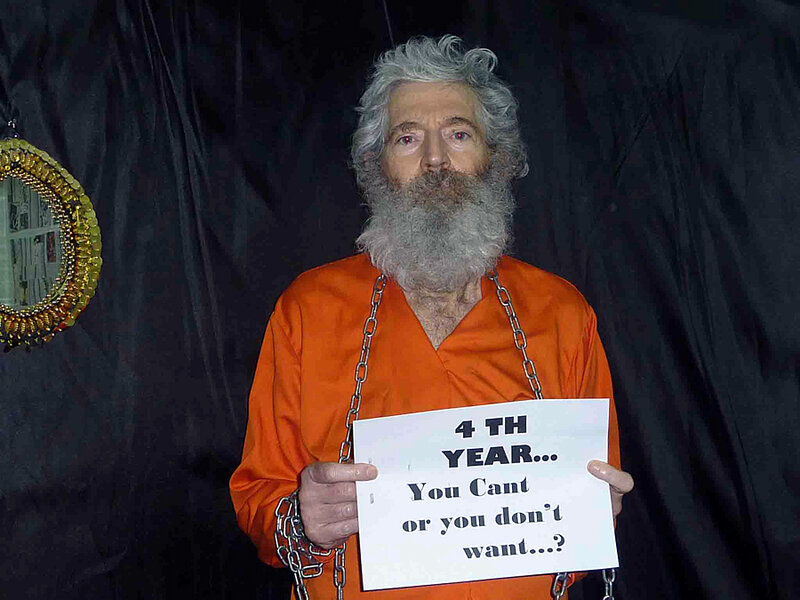Levinson, Iran, the CIA, and lies
There's always been something a little strange about the story of Robert Levinson, the retired FBI agent who disappeared on Kish Island – a sort of smugglers' paradise controlled by Iran in the Persian Gulf, but with much looser rules imposed on entry and exit – in March 2007.
The US government said it had nothing to do with Mr. Levinson and didn't know why he'd gone to Kish. "He's a private citizen involved in private business" the State Department claimed in 2007. His family said he was dispatched to investigate cigarette smuggling for an undisclosed private client. Dawhud Salahuddin (born David Belfield), a US citizen who murdered an Iranian diplomat in Washington D.C. in 1980 at the behest of the new government of Ayatollah Khomeini and has lived in exile in Iran ever since, says he spent Levinson's last night of freedom with him, and in interviews over the years has suggested a government faction had detained him.
Press TV, a government propaganda outlet with which Mr. Salahuddin has worked off and on for years, said shortly after his disappearance that Levinson was in Iranian custody. "Proof of life" videos were occasionally released by Levinson's family, but without any explanation of what if any demands were being made.
You didn't have to be an intelligence pro to know that something didn't make sense about Levinson's predicament. And it turns out part of his problem was that the people he was working with weren't exactly pros.
The Associated Press broke a story yesterday saying that Levinson was working as part of a rogue CIA operation. The truth of that has been kept out of the public eye since 2007 with the cooperation of members of Congress, the Bush and Obama White Houses, and, for the past three years, the Associated Press itself.
While the AP reports that Levinson's handlers were CIA employees, they all appear to have been analysts, rather than employees expert in gathering intelligence themselves and running assets in the field. The AP says the employees running Levinson as their own private collection agent weren't authorized to do so, and that three analysts were quietly sacked in 2007 for their involvement and a further seven admonished.
How did they break the story? The AP writes:
Details of the unusual disappearance were described in documents obtained or reviewed by the AP, plus interviews over several years with dozens of current and former U.S. and foreign officials close to the search for Levinson. Nearly all spoke on condition of anonymity because they were not authorized to discuss the sensitive case.
The AP first confirmed Levinson's CIA ties in 2010 and continued reporting to uncover more details. It agreed three times to delay publishing the story because the U.S. government said it was pursuing promising leads to get him home.
The AP is reporting the story now because, nearly seven years after his disappearance, those efforts have repeatedly come up empty. The government has not received any sign of life in nearly three years. Top U.S. officials, meanwhile, say his captors almost certainly already know about his CIA association.
The New York Times published a version of the Levinson story shortly after the AP's report, and had been sitting on the information for many years as well.
That the AP and other American news operations give more leeway in such matters to the US government rather than private citizens is fairly well established. In 2006, when a colleague of mine was kidnapped in Iraq, the AP observed a news blackout for two days before calling The Christian Science Monitor and saying they couldn't sit on a newsworthy story anymore.
Doesn't add up
Even though the report today answers or resolves a lot of the curious statements about Levinson's disappearance – ie, there was a lot of lying going on – there's still plenty that doesn't add up.
If Levinson was taken by the Iranian government - or a faction within it - Iran could be fairly certain that he was attempting to spy on the country.
And the AP story says Salahuddin was the man that Levinson had exclusively gone to see for information about Iran's nuclear program. A former assassin from North Carolina and an American exile who's frequently talked to journalists in his 35 years and has never expressed any remorse for his actions seems a strange person to know many of Iran's nuclear secrets, or to spill the beans if he did.
He'd also be a strange person for Iranian counterintelligence not to be keeping an eye on, especially since the man who brokered the meeting for Levinson was Ira Silverman, who'd written a 2002 article for The New Yorker suggesting Salahuddin would make an excellent intelligence asset for the US.
A final strangeness is how easily a group of CIA analysts, led by Anne Jablonski according to the AP, managed to break a series of very serious CIA rules for years while not getting caught - even as they used Levinson to create intelligence product to be pushed higher up the chain. Did their training not make clear this was out of bounds? Was no one in a senior position auditing their expenses and activities?
This was six years ago now - long before a young NSA contractor named Edward Snowden was able to flee the United States to Russia with a trove of operational and technical material about American intelligence practices.
How many problems of weak supervision and auditing of employees at US intelligence agencies have we not heard about?






